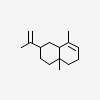English Plantain
Plantago Lanceolata
The English Plantain is found in both the Eastern Deciduous Forest and the Tall Grass Prairie. It is a highly valued herd due to its medicinal properties. The roots can be used to heal snakebites. A decoction of dried leaves promotes blood clotting. Leaves made into a poultice can stop bleeding, heal sores, blisters, and reduce swelling. After being bitten by any bug you can rub fresh plantain leaves around the affected area to reduce swelling and the irritation to itch. A tea made from the leaves can help with diarrhea. The main chemical compound in the Plantain is aucubin. It's chemical formula is C15H22O9.
http://medicinalherbinfo.org/herbs/Plantain.html
http://www.chemspider.com/Chemical-Structure.82585.html?rid=b247a133-49b5-4002-9501-92d692b3b20f
Black Walnut
(Juglans Nigra)
The black walnut tree is found in both the Eastern Deciduous Forest and the Tall Grass Prairie. It has the ability to heal open wounds and sores with the oil from the walnut. A leaf decoction can be used to heal skin irritations like boils and sores. The leaves, bark, and walnut hulls are all used medicinally. You can make a tincture from the leaves for skin and external afflictions. A tea can also be made from the leaves and bark to speed up the healing process of wounds and also as a laxative. You can eat the walnut as it is full of vitamins and minerals. The chemical in the walnut is tannin. Tannin's chemical formula is C27H24O18.
 Tannin
Tanninhttp://www.herballegacy.com/Berry_Medicinal.html
http://altnature.com/gallery/blackwalnut.htm
http://www.chemindustry.com/chemicals/15140.html
http://pubchem.ncbi.nlm.nih.gov/compound/452707#section=2D-Structure
Common Juniper
(Juniperus communis)
The common juniper is found in the the Eastern Deciduous Forest and the Tall Grass Prairie. It is usually found in fields and rocky areas with well drained soil. Can be found at the edge of the woods. It has many medicinal benefits thus being a valuable plant to be able to properly identify. It has small berries all over it that are responsible for most of the healing. They can heal snake bites by creating an oil from the fruits and topically applying. You can also apply this to wounds as a disinfectant. Beware the fruits for they are toxic in frequently high doses. Juniper's active chemical ingredient is alpha selinene. The chemical formula for it is C15H24.
 alpha-selinene
alpha-selinene http://www.bio.brandeis.edu/fieldbio/medicinal_plants/pages/Common_Juniper.html
http://www.naturalmedicinalherbs.net/herbs/j/juniperus-communis=juniper.php
http://www.chemindustry.com/chemicals/0300809.html
White Willow
(salix alba)
The White willow is found in the Eastern Deciduous Forest and the Tall Grass Prairie.
It prefers temperate areas with direct sunlight and plenty of moisture. The active chemical ingredient in the bark of the willow tree is salicin. To ingest this chemical, you can make a tea from the bark or just directly suck/chew on the bark. By taking salicin, you can reduce pain stimuli and inflammation.The branches are malleable and lengthy so they make excellent cordage. You can construct a temporary splint with some sturdy sticks and the branches from the willow. This can cure any malady that has pain/swelling symptoms. The chemical formula of salicin is C13H18O7.
 Salicin
Salicinhttp://www.webmd.com/vitamins-supplements/ingredientmono-955-willow%20bark.aspx?activeingredientid=955&activeingredientname=willow%20bark
http://www.naturalmedicinefacts.info/plant/salix-alba.html
http://www.mdidea.com/products/phytochemical/salicin01.html
White Pine Tree
(Pinus strobus)
The white pine is the tallest native coniferous tree. It is found in only wooded areas and has many medicinal purposes. Those include: suppressing cold and flu symptoms, accelerating the healing process, bracing broken limbs, and stitching together wounds like knife cuts and ax wounds. A section of custom cut bark can be fixed to the broken limb to act as a temporary cast. Directly applying the sap of the tree can stop bleeding and initiate the healing process. Sapling bark can be used as stitches for wounds that are gaping and need to be sealed fast. A tincture can be crafted from the pine resin/sap to treat a cough/cold. A tea made from the needles can treat a sore throat. The active chemical ingredient in the white pine is chrysin. The chemical formula is C15H10O4. The dried inner bark also contains 10% tannin.
http://www.naturalmedicinalherbs.net/herbs/p/pinus-strobus=white-pine.php
http://medicinalherbinfo.org/herbs/WhitePine.html
http://www.chemspider.com/Chemical-Structure.4444926.html
http://www.susunweed.com/Article_Pine-Keeps-You-Fine.htm
http://www.chemspider.com/Chemical-Structure.25031915.html?rid=8d4dc7d3-9d66-43b8-9804-92a207ee0222
Peppermint
(Mentha piperita)
The peppermint is found in both Eastern Deciduous Forest and the Tall Grass Prairie. It is easily identified due to it's distinct odor of mints. The habitat includes fields, roadsides, and anywhere with damp soil. The medicinal effects of the plant are treating flu symptoms, diarrhea, dermatitis, reducing pain and sensitivity, and the leaves are an antibacterial/antiseptic. To ease flu symptoms, you can make a tea from the leaves. Masticating the leaves and stems and applying the oil to the skin can reduce the pain of the area and it can heal rashes. Applying the essential oil of the leaves to any wound can cleanse it before wrapping it up. The active ingredient in peppermint is menthol. Menthol's chemical formula is C10H20O.
http://www.naturalmedicinalherbs.net/herbs/m/mentha-x-piperita-officinalis=white-peppermint.php
http://www.chemspider.com/Search.aspx?q=menthol
No comments:
Post a Comment